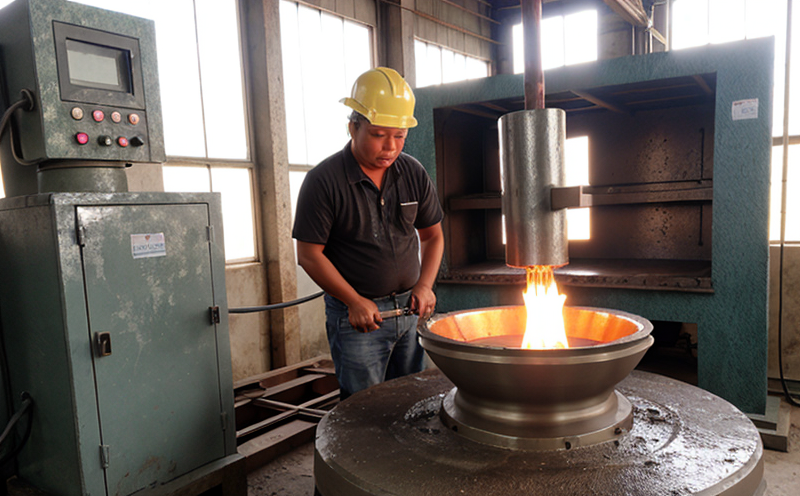ISO 8082 Inclusion Rating Testing in Foundry Materials
The ISO 8082 standard is crucial for evaluating the quality and integrity of cast iron materials used in industrial manufacturing processes. This test measures the inclusion rating, which assesses the presence and concentration of non-metallic inclusions within cast iron products. These inclusions can significantly impact the mechanical properties and overall performance of the final product.
The importance of this testing cannot be overstated, especially for industries where quality and reliability are paramount. By identifying and quantifying inclusions early in the manufacturing process, manufacturers can take corrective actions to improve the casting process and ensure compliance with industry standards. This service is essential for companies involved in foundry operations, as it helps them maintain a high level of product integrity.
The testing procedure involves several steps that are meticulously outlined in ISO 8082. The first step is to prepare the sample by cleaning and sectioning the cast iron specimen. This preparation ensures that any surface contamination or damage does not interfere with the results. Once prepared, the sample undergoes a detailed examination under magnification. High-resolution microscopes are used to identify and classify inclusions based on their morphology.
The classification of inclusions is critical as it allows for accurate quantification. Common types of inclusions include oxide films, sulfides, silicates, and graphite nodules. Each type has a specific impact on the mechanical properties of the cast iron. For instance, high concentrations of sulfides can lead to embrittlement, while excessive oxide films may affect the machinability of the material.
The testing process also involves measuring the inclusion rating, which is expressed as a percentage by volume. This measurement is crucial for compliance with international standards and quality control protocols. The inclusion rating provides valuable insights into the casting process, helping manufacturers identify potential issues such as improper alloying or contamination during pouring.
In addition to the visual inspection under magnification, advanced techniques like X-ray fluorescence (XRF) can be used to further analyze the inclusions. This non-destructive testing method allows for a more detailed examination of elemental composition and distribution within the sample. The results from these tests are then compiled into a comprehensive report that includes both qualitative and quantitative data.
| Step | Description |
|---|---|
| Sample Preparation | Cleaning, sectioning, and preparing the cast iron specimen for examination. |
| Microscopic Examination | Evaluating inclusions under high-resolution microscopes to identify and classify them. |
| Inclusion Rating Measurement | Determining the inclusion rating as a percentage by volume for each type of inclusion. |
| Advanced Analysis (Optional) | Using XRF to analyze elemental composition and distribution within the sample. |
Applied Standards
The ISO 8082 standard is widely recognized for its robustness and reliability in assessing inclusion ratings in cast iron materials. This standard ensures that the testing process adheres to international best practices, providing consistent and accurate results across different laboratories.
ISO 8082:1995 specifies the method of determining the inclusion rating by volume fraction for cast iron products. It covers various types of inclusions commonly found in these materials, including oxide films, sulfides, silicates, and graphite nodules. The standard also provides guidelines on sample preparation, examination techniques, and reporting procedures.
By following this standard, laboratories can ensure that their testing processes are consistent with international norms, enhancing the credibility of their results. This is particularly important for industries that rely heavily on cast iron products, such as automotive manufacturing, construction, and heavy machinery production.
Scope and Methodology
| Step | Description |
|---|---|
| Sample Preparation | Cleaning the cast iron specimen to remove any surface contaminants and ensuring it is representative of the casting batch. |
| Microscopic Examination | Evaluating inclusions under high-resolution microscopes, classifying them based on their morphology, and measuring inclusion volume fractions. |
| Advanced Analysis (Optional) | Using XRF to analyze elemental composition and distribution within the sample for a more detailed examination of inclusions. |
Use Cases and Application Examples
- Quality Control: Ensuring that cast iron products meet the required quality standards by identifying and quantifying inclusions.
- R&D: Investigating the effects of different casting parameters on inclusion formation and distribution.
- Compliance: Meeting regulatory requirements for materials used in critical applications, such as aerospace or automotive components.
The results from ISO 8082 testing are invaluable for these use cases. For instance, during quality control, the inclusion rating is compared against established thresholds to determine if a batch of cast iron meets specifications. In R&D settings, this test helps researchers understand how changes in alloy composition or casting technique affect the formation and distribution of inclusions.
Compliance with ISO 8082 ensures that materials used in critical applications meet stringent quality standards. This is particularly important for industries where product safety and reliability are paramount. For example, in aerospace manufacturing, any defects in cast iron components could lead to catastrophic failures, underscoring the importance of rigorous testing.
| Use Case | Description |
|---|---|
| Quality Control | Ensuring cast iron products meet the required quality standards by identifying and quantifying inclusions. |
| R&D | Investigating the effects of different casting parameters on inclusion formation and distribution. |
| Compliance | Meeting regulatory requirements for materials used in critical applications, such as aerospace or automotive components. |





